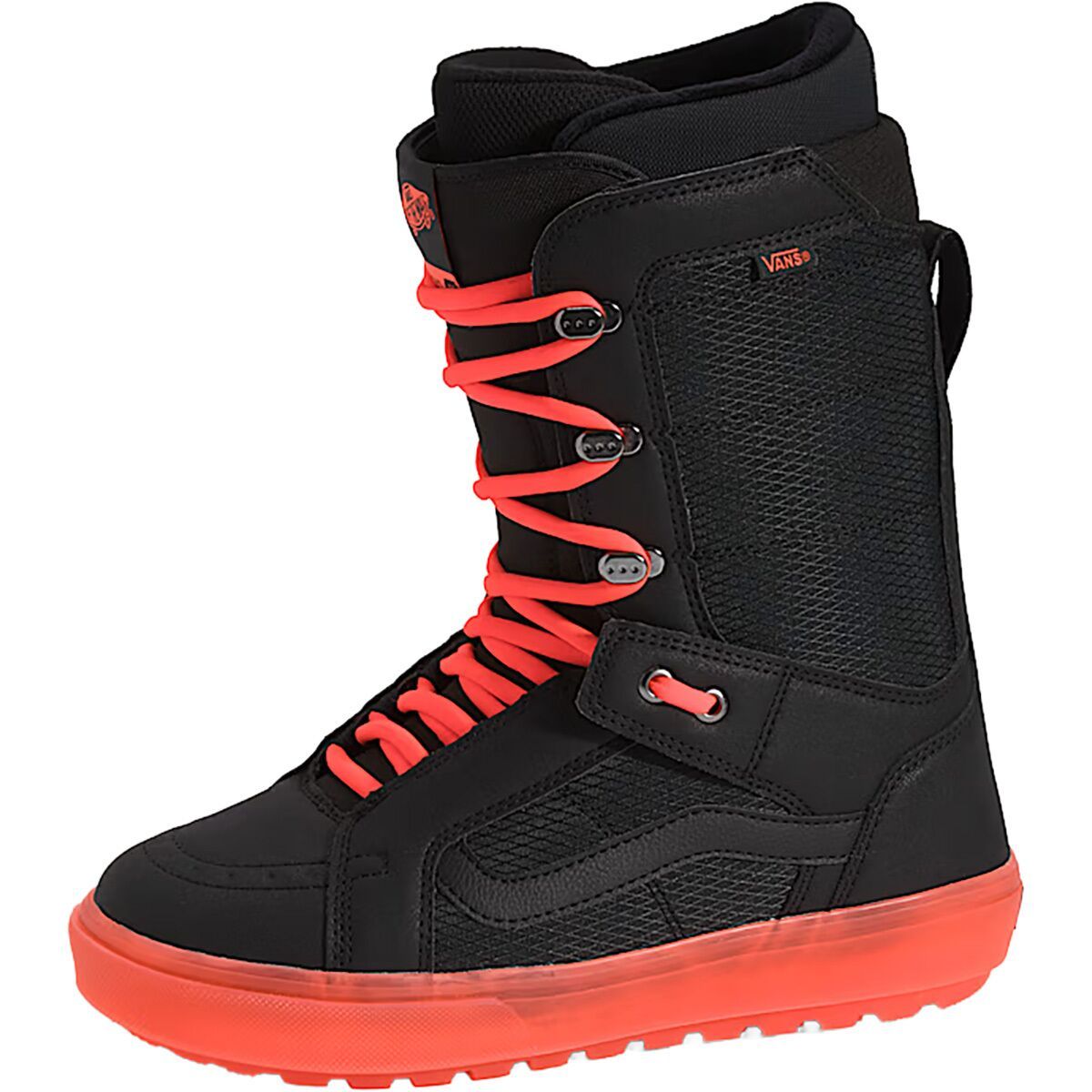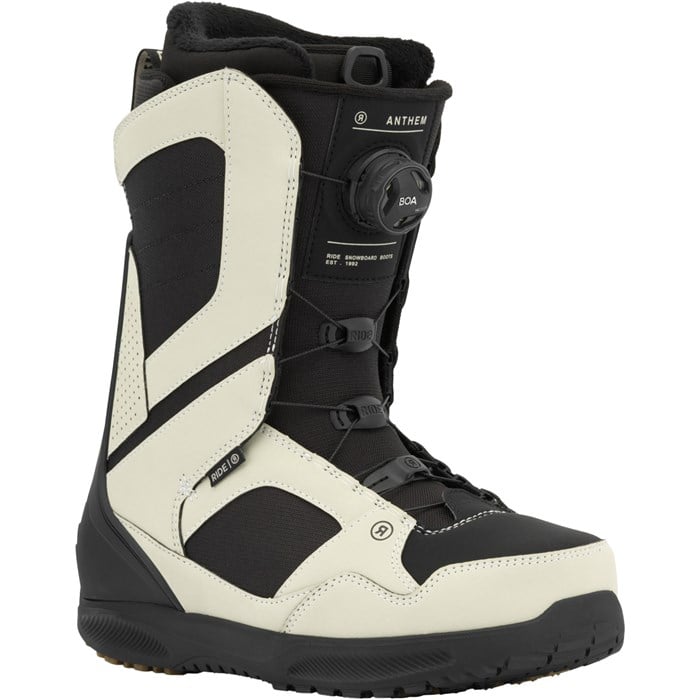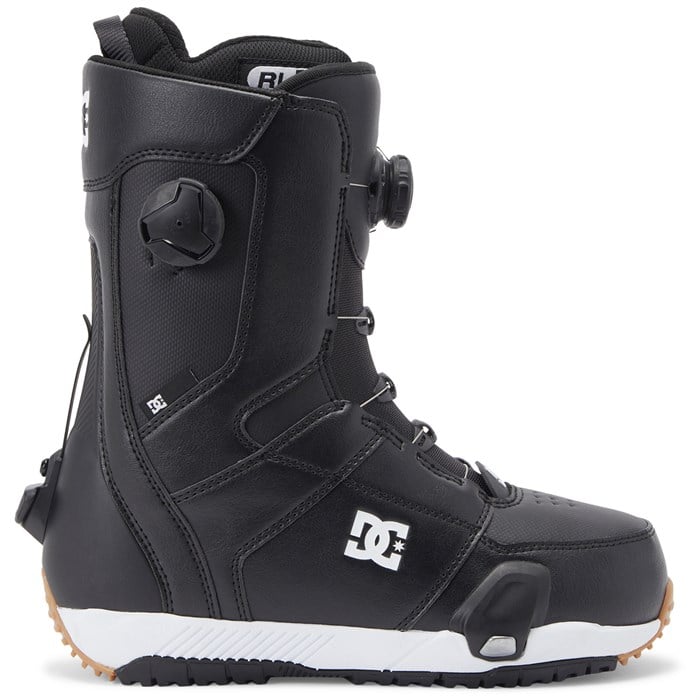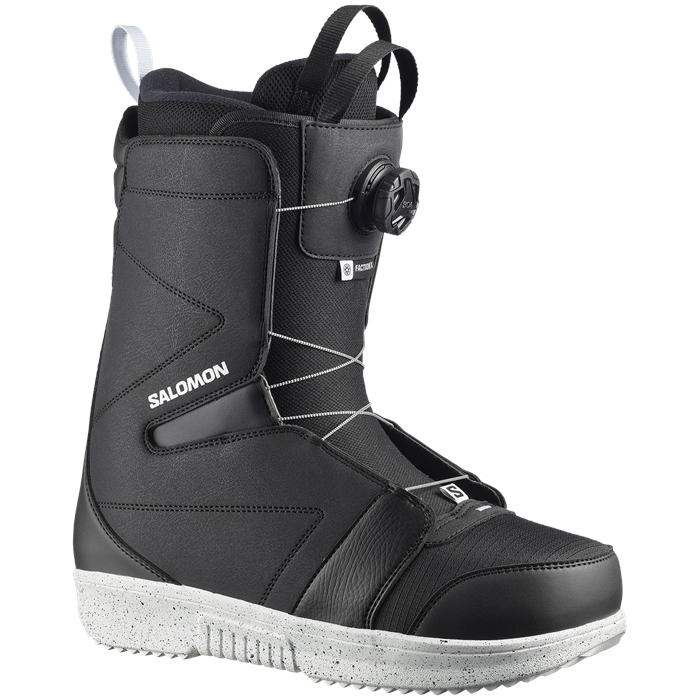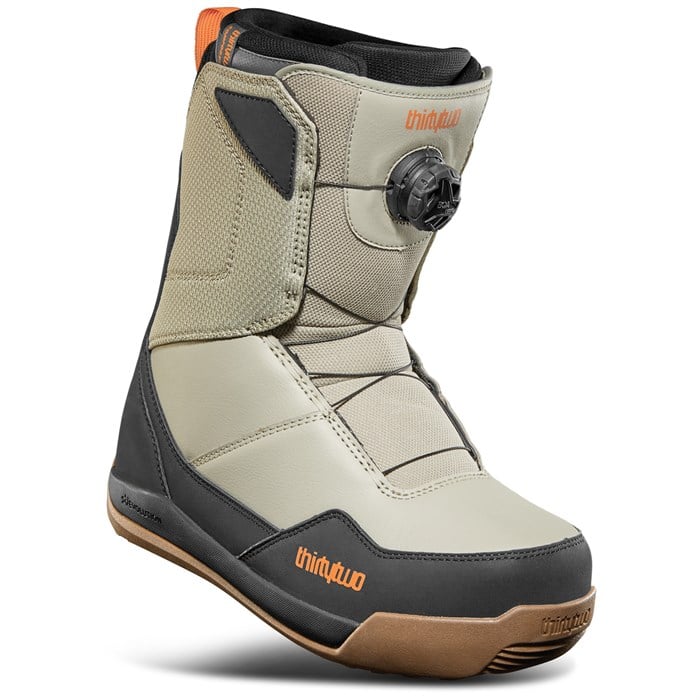Most beginner boot lists miss the point. They’ll throw in whatever’s on sale and call it “beginner friendly.” I’ve spent enough time teaching and fitting riders to know which snowboard boots actually make your first days easier.
These are the ones that stay warm and feel good straight out of the box. If you just want boots that help you progress without wrecking your feet, start here. The (un)official best beginner snowboard boots of 2026.
🏆 Best Overall Pick
The Burton Moto BOA are the best snowboard boot for beginners. They're soft, warm and easy to tighten with a single BOA dial. Comfortable right out of the box and forgiving enough to help you learn faster without wrecking your feet. It’s the boot most instructors recommend.
Top 3 Beginner Snowboard Boots
Beginner Snowboard Boot Reviews
1. Burton Moto BOA Best Overall
- Flex: 3 to 4 out of 10
- Lacing: Single BOA
- Liner: Imprint 1 heat moldable
- Outsole: DynoLITE with shrinkage footprint reduction
- Fit notes: Easy break in, forgiving cuff, good warmth
The Burton Moto is the boot I’ve seen on more beginner feet than probably anything else. There’s a good reason for that. It’s soft, forgiving and super easy to get on and off with the single BOA. If you’re just learning how to link turns or spending long days in lessons, it keeps things simple and comfortable.
The liner breaks in fast and the fit is roomy enough that you don’t feel crushed. I’ve had students wear these all week without a single complaint about pressure points, which is rare. The flex is mellow, so they move naturally with you instead of fighting your ankle when you fall or lean wrong.


The trade-off is you’ll outgrow them if you start riding more aggressively. Once you’re carving faster or starting small jumps, the Moto can start to feel a bit too soft underfoot. It’s not built for big mountain or long-term progression, but that’s not really what it’s for.
If you just want something that’s warm, comfy and gets you through your first couple seasons without foot pain, the Moto is still the easiest recommendation out there.
Pros
- Warm, comfortable, easy to break in
- Single BOA is fast and convenient
- Forgiving flex for new riders
- Very reasonable pricepoint
- Trusted, proven choice for beginners
Cons
- Too soft once you start riding faster
- Not ideal for heavier riders or steep terrain
2. Vans Hi-Standard OG Value Pick
- Flex: 4 out of 10
- Lacing: Traditional lace
- Liner: V1 heat moldable
- Outsole: V1 Waffle Lug
- Fit notes: Comfy out of the box, easy flex, warm for cold mornings
The Hi-Standard OG has been around forever and that’s because it just works. It’s the definition of a no-nonsense beginner boot. Classic lace system, medium-soft flex and that mellow Vans skate-shoe feel that makes it comfortable right out of the box.
I’ve had riders show up in these on their very first lesson and ride all week without a single issue. They don’t pinch, they don’t slip and they feel natural underfoot. The flex has enough give to forgive mistakes, but enough structure that you can actually start carving without feeling like your ankles are made of jelly.

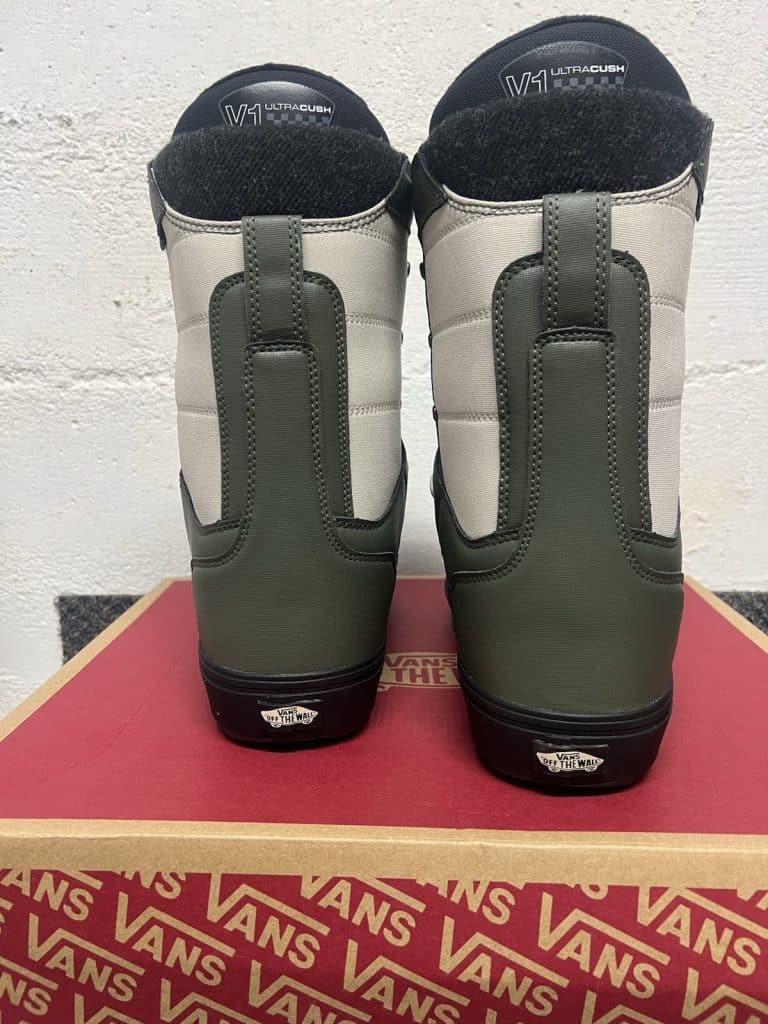
There’s no BOA, which some people might see as a downside, but honestly, it’s part of what keeps these feeling simple and durable. If you don’t mind tightening laces, they’ll fit better and last longer than most cheap BOA boots.
They’re not as warm as the higher-end Vans models, and you’ll eventually want something stiffer if you stick with it. But for the money, the Hi-Standard OG nails that comfort-to-control balance that beginners need.
Pros
- Classic fit and feel that just works
- Comfortable straight out of the box
- Great control for new riders
- Solid durability for the price
- Incredible bang for your buck
Cons
- No BOA system for quick entry
- Can pack out faster than premium liners
3. Burton Ruler BOA Progression Pick
- Flex: 5 to 6 out of 10
- Lacing: Dual BOA
- Liner: Imprint 2 heat moldable
- Outsole: DynoGRIP with B3 gel
- Fit notes: Strong heel hold, more support for faster progression, warm and secure feel
The Burton Ruler BOA is what I usually recommend to anyone who’s past their first few days and wants boots that won’t hold them back next season. It’s a solid step-up from softer beginner snowboard boots, but still easy enough to ride if you’re new.
The dual BOA system gives a snug fit that actually stays locked in, which means better edge control and less heel lift when you start carving harder. The liner is heat-moldable, so you can get that custom feel after a day or two of riding. I’ve ridden these myself and they strike that rare middle ground between comfort and support.
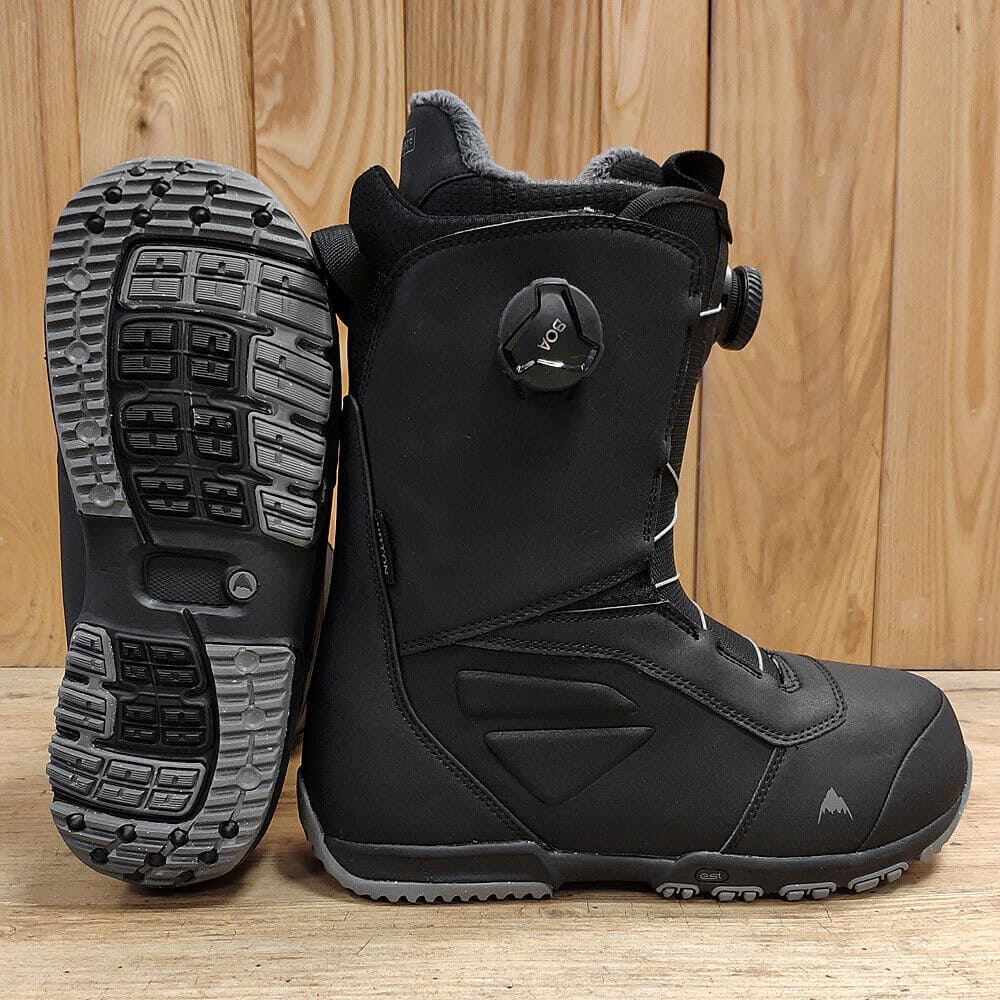
They’re not cheap and the flex is firmer than true beginner models like the Moto, but that’s also why you’ll keep riding them for a few seasons. They hold up well, handle steeper terrain and still feel forgiving enough if you make mistakes.
If you’re serious about learning fast or you just don’t want to buy another pair in a year, the Ruler BOA is the best beginners snowboard boot for progression.
I’d probably pick this one myself if I was starting over. Though if you’re a total first-timer, the Moto will still make those first few days a bit easier.
Pros
- Dual BOA gives precise, locked-in fit
- Supportive flex for long-term progression
- Heat-moldable liners
- More tech than pure beginner picks
- Been around forever, with over a decade of refinement
Cons
- Stiffer flex can feel demanding for brand-new riders
- More expensive than pure beginner boots
4. Ride Anthem Comfort Pick
- Flex: 4 to 5 out of 10
- Lacing: Single BOA
- Liner: 3D moulded Intuition heat moldable
- Outsole: GripLite with Impact Sole
- Fit notes: Extra heel hold, solid for progressing fast without feeling stiff
The Ride Anthem is one of those boots that makes long days on the hill a lot easier. Everyone’s definition of “comfortable” is different, but these really do fit that middle ground most riders like. The liner feels plush without being sloppy. The flex is soft enough to stay forgiving when you’re still figuring things out.
The single BOA tightens evenly, which helps avoid that weird pinch across the top of your foot that some boots give you. They’re warm too, which I notice a lot when teaching long lessons in cold conditions. You don’t get that numb toe feeling that cheaper boots sometimes cause.
They’re not perfect. If you’ve got narrow feet, you might find them a bit roomy, and they don’t have the same precision as something like the Burton Ruler. But if your goal is a boot you can ride all day without sore spots or pressure points, the Anthem nails it.
It’s a great pick for new snowboarders who value comfort first and want something that feels broken in from day one.
Pros
- Soft flex makes riding easy and forgiving
- Warm and comfortable liner
- Even BOA tension across the foot
- Great for long days on snow
Cons
- Can feel roomy for narrow feet
- Not ideal for faster, more aggressive riding
5. Burton Mint BOA Best Women’s Pick
- Flex: 3 out of 10
- Lacing: Single BOA
- Liner: Imprint 1 women’s specific
- Outsole: Lightweight with footprint reduction
- Fit notes: Soft cuff and easy break in with warm feel for first days on snow
The Burton Mint BOA are the best women’s snowboard boots for beginners. They’ve been around forever because they just work. The fit is warm, soft and forgiving, which makes those first few days so much easier.
The single BOA tightens evenly and makes it quick to get in and out. The liner molds to your feet after a couple of rides and holds warmth better than most boots in this range. I’ve seen plenty of riders go from day one to linking turns in these without a single complaint.
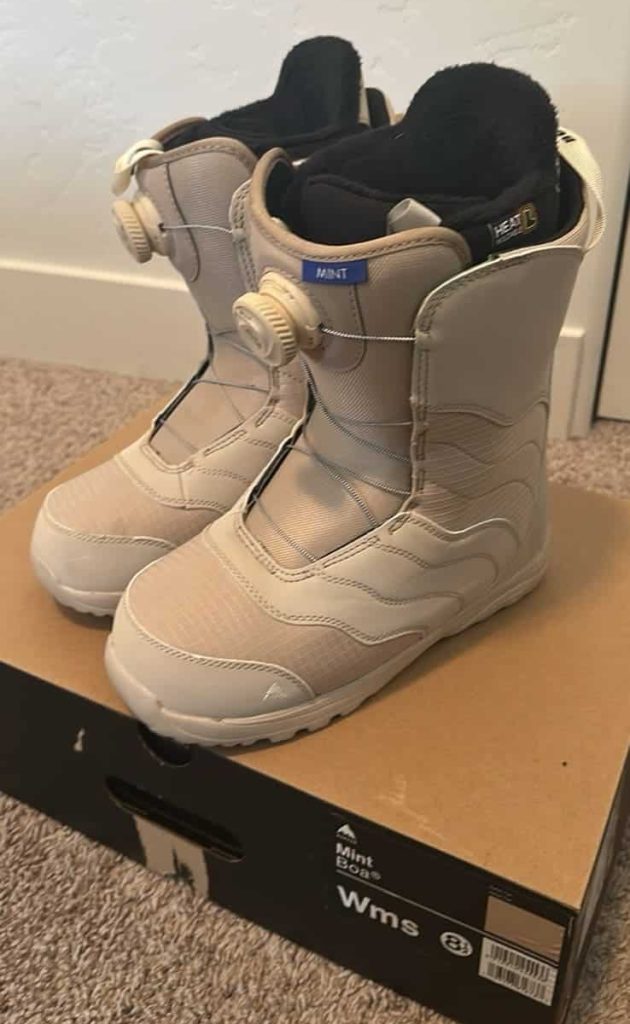
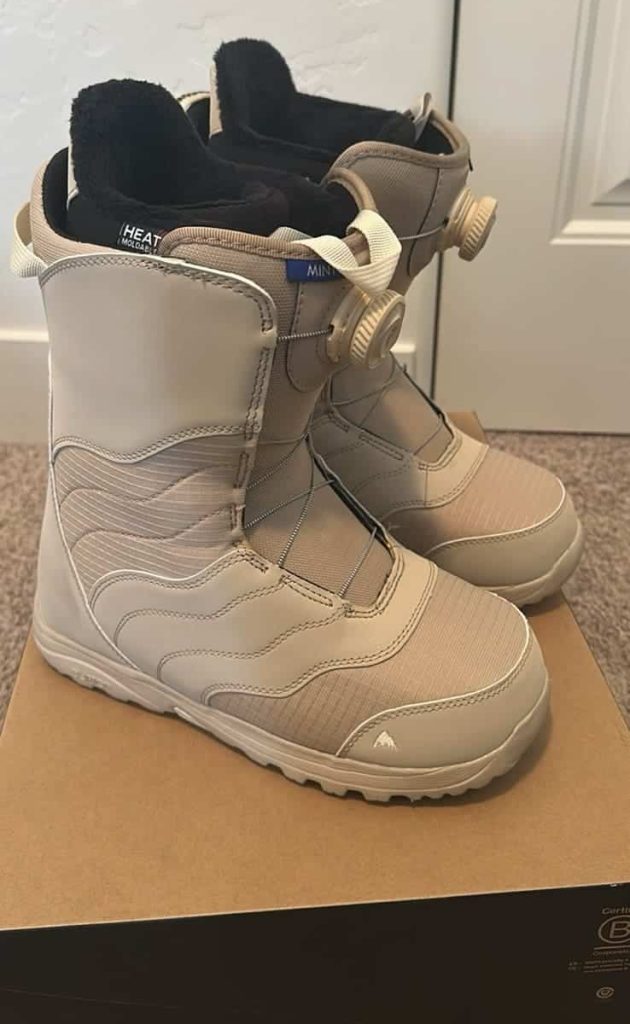
Jess (my co-founder and fellow instructor) swears by the Mint for her new students. She says it’s one of the few boots that feels broken in straight out of the box and doesn’t wreck your feet after a full day on snow.
They’re soft, which is what you want when you’re learning, but you’ll eventually outgrow them if you start riding faster or tackling steeper runs. Still, for comfort, warmth and value, the Mint BOA is hands down the best beginner snowboard boot for Women.
Pros
- Soft, warm and forgiving fit
- Easy BOA closure system
- Breaks in quickly and stays comfortable
- Highly recommended by instructors for new riders
Cons
- Likely too soft for aggressive or fast riding
- Single BOA is less customisable than dual
6. Bataleon Shift BOA Best Newcomer
- Flex: about 4 out of 10
- Lacing: Single BOA
- Liner: P1 Performance, heat moldable
- Outsole: SureGrip rubber
- Fit notes: Light feel, easy break in, playful and comfy for first seasons
I was honestly stoked to see Bataleon jump into snowboard boots. They’ve nailed boards for years, so the Twist BOA had a lot to live up to. Turns out, it’s way better than I expected for a first release.
The fit feels natural right away, with a flex that sits right in that sweet beginner zone. It’s soft enough to be forgiving when you catch an edge, but supportive enough to grow with you as your riding improves. The single BOA makes tightening quick and easy and the shell feels well-built, not like a rushed first attempt.
The liner is where Bataleon really surprised me. It’s plush, warm and holds your heel nicely. I’ve seen a few newer riders on these this season and they’ve all been happy with them. That’s not something you can say about most new brands breaking into boots.
They’re not quite as dialed-in as something from Burton or Ride yet, but for a new release, they’re a solid option if you want something stylish, comfortable and ready to progress with you.
Pros
- Comfortable and forgiving straight out of the box
- Great flex balance for new riders
- Stylish design and solid first effort from Bataleon
- Easy BOA system for quick entry
Cons
- Not as proven long-term as legacy brands
- Some riders might prefer a dual BOA for better lockdown
7. DC Control Step On Best Step-On Pick
- Flex: 4 out of 10
- Lacing: Dual BOA with Step On system
- Liner: Response II, heat moldable
- Outsole: Step On compatible cup sole
- Fit notes: Supportive yet forgiving, ideal for progressing riders who want a cleaner setup and zero fuss
I’ve ridden both Burton and DC Step On boots and for beginners I’d pick the DC Control every time. It’s easier to ride, fits better straight out of the box and feels more forgiving when you’re still figuring things out.
The dual BOA system is what makes it shine. You can tighten the top and bottom separately, so your heel stays locked in without crushing your foot. The flex sits right in that beginner sweet spot. Supportive enough to help you balance, soft enough to let you move naturally.

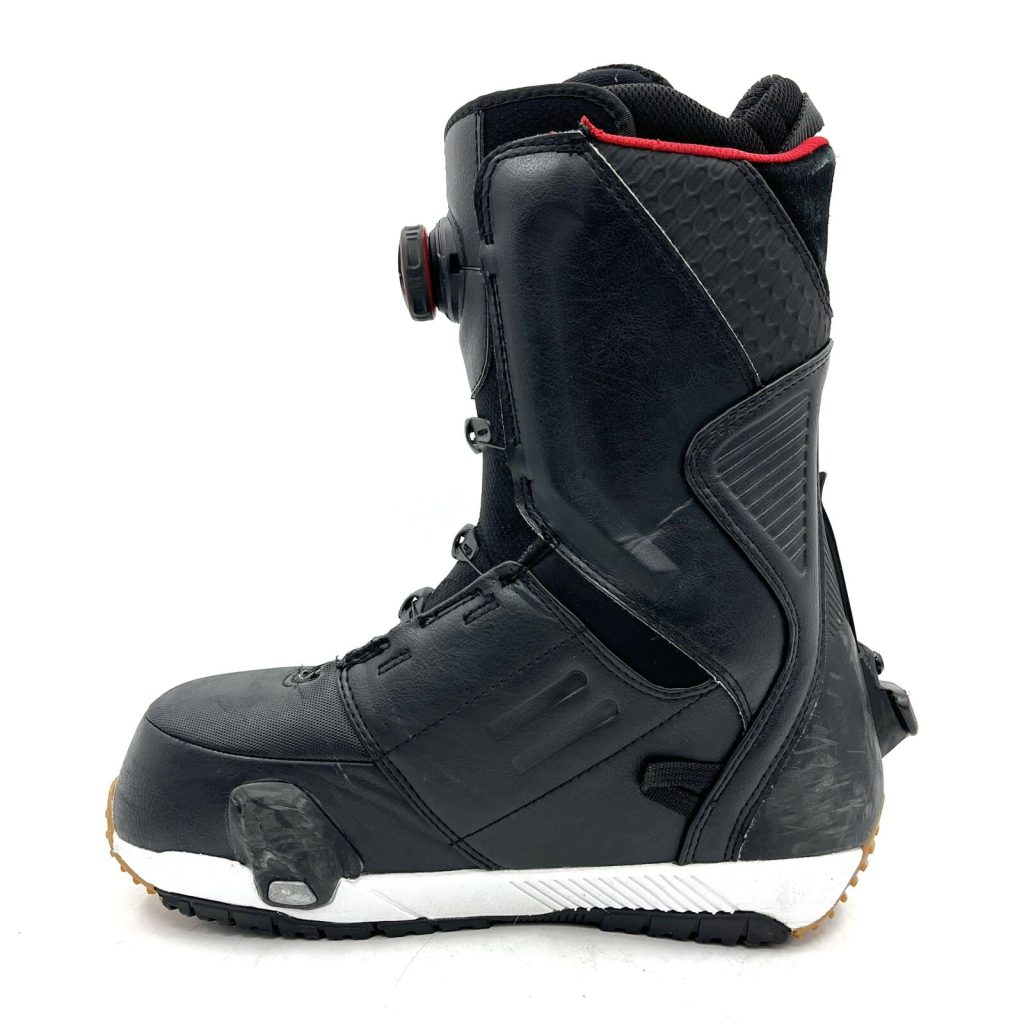
The fit is classic DC. Slightly wider, warmer and less cramped than Burton’s Step On boots. The liner breaks in quickly and stays comfortable even after a full day of lessons or laps.
They do cost more and you’ll need matching Step On bindings, but if you want something simple that actually helps you learn faster and stay comfortable, this is it. The DC Control Step On is the best Step On snowboard boot for beginners.
Pros
- More forgiving than Burton’s Step On boots
- Dual BOA - adjustable, secure fit
- Warm liner that breaks in fast
- Better shape for wider feet
- Great durability - should last a good few seasons
Cons
- Pricey because of Step On compatibility
- Too soft for faster or more aggressive riders
8. Salomon Faction BOA
- Flex: 4 out of 10
- Lacing: Single BOA
- Liner: Twinframe Cage + heat-moldable liner
- Outsole: EVA blended moulded comp for comfort
- Fit notes: Lightweight, comfy for first season, warm enough and easy on the feet
The Salomon Faction BOA is one of those boots that just gets the basics right. It’s light, simple and easy to ride in. That makes it perfect for beginners who want something they can wear all day without thinking about it.
The soft flex makes learning turns feel smoother. It’s forgiving but still gives enough support when you start linking runs together. The BOA system works well here too. It tightens evenly and holds without overdoing it.
The fit runs a little on the narrow side. If you have wide feet, you’ll probably feel that straight away. They’re also not a boot you’ll keep once you’re charging steeper terrain, but that’s not what they’re for. For learning, progressing and staying comfortable, they’re a great option.
Pros
- Lightweight and easy to wear
- Soft flex helps beginners progress
- Comfortable liner from the first day
- Simple BOA system for quick setup
Cons
- Fit is tight for wider feet
- Too soft for advanced terrain or heavier riders
9. ThirtyTwo Shift BOA
- Flex: 3 out of 10
- Lacing: Single BOA
- Liner: Comfort Fit, heat moldable
- Outsole: Evolution Foam
- Fit notes: Super soft, lightweight, and ideal for true beginners who value comfort and forgiveness
ThirtyTwo makes some of the best-looking snowboard gear out there and the Shifty BOA keeps that same vibe. It’s one of those boots that looks good, feels good and does exactly what a beginner boot should do (without trying too hard).
The fit is soft and relaxed. The liner feels plush the moment you put it on. The BOA system is clean and quick. ThirtyTwo’s team actually rides in the gear they design and you can tell. There’s real attention to how the boot flexes and supports your stance when you’re learning.
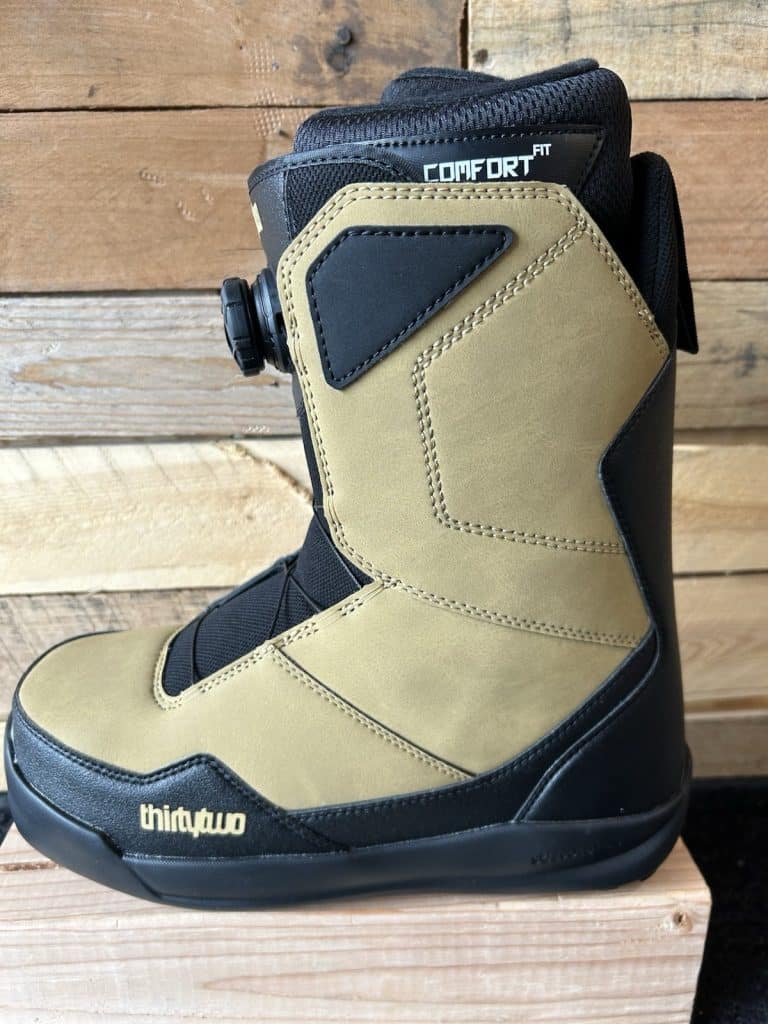

It’s not a powerhouse boot, and it’s not meant to be. The Shifty is made for cruising, park laps and slow progression days where comfort and style matter most. You might not be carving black runs in it, but you’ll have a boot that makes you want to ride more.
If you care about fit and feel as much as performance, the ThirtyTwo Shifty BOA is one of the best beginner snowboard boots of 2026.
Pros
- Soft, easy fit that feels great straight away
- Stylish with great build quality
- Lightweight and well-balanced flex
- Ideal for casual cruising or first seasons
Cons
- Too soft once you start riding way steeper terrain
- Not built for high-speed performance
10. DC Phase
- Flex: 4 out of 10
- Lacing: Traditional lace
- Liner: Response Liner with EVA
- Outsole: Foundation UniLite
- Fit notes: Soft friendly flex, easy to wear all day, good comfort for first seasons
The DC Phase is about as straightforward as snowboard boots get. Exactly why I like it. No gimmicks, no flashy tech, just a solid boot that fits well and rides great for a first setup.
The flex is soft, which makes it forgiving when you’re still learning balance and control. The traditional lace system takes a little longer to do up, but it gives you a consistent fit and holds better than you’d expect for the price. The liner is simple but comfortable enough to ride all day without pressure points or sore spots.
It’s not warmest boot out there, and it won’t blow anyone away with features, but it’s reliable. I’ve seen these last multiple seasons for riders who only get a few trips a year. For the money, that’s hard to complain about.
If you just want a boot that fits, rides fine and lets you save cash for lift tickets or lessons, the DC Phase is still a contender.
Pros
- Great price for the quality
- Soft flex that’s easy to control
- Simple, durable lace system
- Comfortable enough for long lessons or full days
Cons
- Not the warmest liner
- Lacks advanced support for steeper riding
Comparison Table
Here’s a quick side-by-side look at every beginner boot I rated for 2026.
| Boot | Flex | Lacing | Liner | Fit | Style | Score | Price |
|---|---|---|---|---|---|---|---|
| Burton Moto BOA | 4/10 | Single BOA | Imprint 1+ Heat Moldable | Soft, warm, forgiving | Beginner / All-Mountain | 4.7/5 | $239 |
| Vans Hi-Standard OG | 5/10 | Traditional Lace | V1 Ultracush | Classic fit, supportive and comfy | Beginner / Freestyle | 4.6/5 | $199 |
| Burton Ruler BOA | 6/10 | Dual BOA | Imprint 2 Heat Moldable | More supportive, great for fast learners | All-Mountain / Step-Up | 4.8/5 | $329 |
| Ride Anthem BOA | 4/10 | Single BOA | Intuition Plush | Roomy, warm, all-day comfort | Beginner / Comfort | 4.6/5 | $229 |
| Burton Mint BOA (W) | 3/10 | Single BOA | Imprint 1+ Women’s | Soft, warm, easy to break in | Women’s Beginner | 4.6/5 | $239 |
| Bataleon Twist BOA | 4/10 | Single BOA | Heat Moldable | Soft, playful, progression-friendly | Men’s All-Mountain / Freestyle | 4.5/5 | $259 |
| Salomon Faction BOA | 4/10 | Single BOA | Custom Fit | Supportive with mellow flex | All-Mountain Beginner | 4.5/5 | $249 |
| DC Control Step On | 4/10 | Dual BOA + Step On | Response II | Secure and convenient fit | Step On / Progression | 4.7/5 | $379 |
| ThirtyTwo Shifty BOA | 3/10 | Single BOA | Comfort Fit | Soft, cushy, ideal for day-one riders | Beginner / Park Casual | 4.4/5 | $199 |
| DC Phase | 4/10 | Traditional Lace | Thermoform EVA | Simple, durable, budget-friendly | Beginner / Value Pick | 4.3/5 | $169 |
Beginner Snowboard Boot Buying Guide
I’ve helped a lot of riders pick their first boots. Most people overthink it. You don’t need fancy tech or a “pro model.” You just need boots that fit right, flex naturally and don’t wreck your feet after two hours.
Good boots are the most important part of your setup. If your feet hurt, your whole day sucks. Simple as that. Snowboarding is supposed to be fun, not torture.
Here’s what to look for:
Fit
Your boots should feel snug, not painful. Your toes should gently brush the end when you stand up straight and pull back when you bend your knees. That’s normal. They’ll pack out a little as you ride, so don’t size up thinking they’ll be more comfortable. That’s the fastest way to lose control.
If your heel lifts when you flex forward, try another model. Heel hold is everything.
Flex
Soft to medium flex makes learning smoother. It lets you bend and move naturally instead of fighting the boot. Too stiff and you’ll feel like your legs are in plaster. Too soft and you’ll have no support when you start riding faster. Most beginner boots sit in that nice middle ground already.
Lacing Systems
Traditional laces, BOA and speed laces all work fine. BOA is easy and quick (my personal preference), which is great for beginners who don’t want to mess with frozen laces. Single BOA is fine initially but Dual BOA (one for the upper and lower part of the boot) gives you more adjustability. Traditional laces give you even more control over tightness but take longer to adjust. There’s no wrong choice here. Pick what feels easiest to live with.
Liners
Most boots have decent liners these days. Heat-moldable liners are a bonus, but not essential. Shops can fit these to your feet and it makes a huge difference. They’ll feel more supportive and break in faster. Avoid cheap one-piece liners that feel like slippers.
Socks
Wear one good snowboard sock. Not two. Not your gym socks. Snowboard socks are designed to stay warm and wick moisture. Thick socks don’t make you warmer; they just mess with fit.
Price
Good beginner boots live around $200-$300. You can go higher, but you’re mostly paying for extra features or stiffer flex. Cheaper than that and you start getting junky materials that don’t last or pack out fast.
Common Mistakes
Don’t size up. Don’t buy boots just because they match your board. Don’t buy the stiffest thing on sale because someone told you it’s “better quality.” You’ll hate it. Comfort and fit come first. Everything else is extra.
Final Word
Soft to medium flex, proper fit and a liner that molds to your foot. That’s your formula. Boots are what connect you to the board, so they’re worth the time and money to get right.
If you take one thing away from this: spend more effort choosing boots than your board. The right boots make learning easier, turning smoother and snowboarding a lot more fun.
Once you have your boots dialled, you’re ready to choose a board -> the best snowboard for beginners.
Final Thoughts
I’ve seen more people quit snowboarding over bad boots than bad boards. When your feet hurt, nothing else matters. The right beginner boots should feel comfortable, stay warm and give you control without fighting you.
You don’t need to overcomplicate it. Pick something soft or medium, make sure it fits snug and go ride. That’s it.
If you just want something easy and proven, start with the Burton Moto or the ThirtyTwo Shifty BOA. If you want boots that’ll stay with you longer, the Burton Ruler BOA is worth the extra.
Whatever you choose, don’t stress it too much. Get the fit right, break them in and spend your time riding instead of fiddling with gear. Hope that helps!





